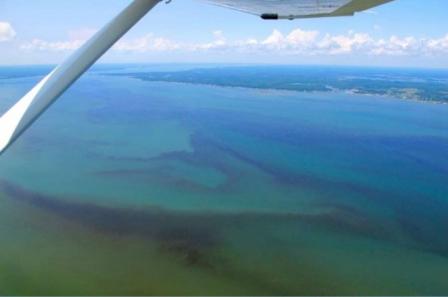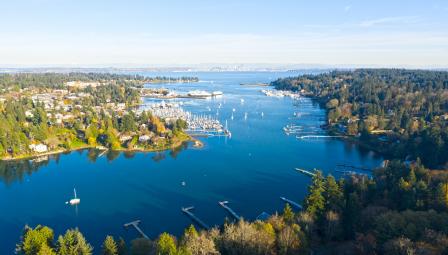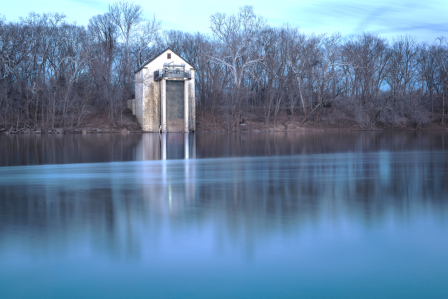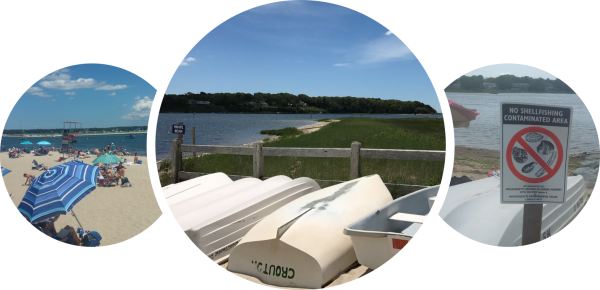Human Dimensions of Water Quality Research
On this Page
Water is one of our most precious resources. We depend upon it for our livelihoods, healthy ecosystems and people, and a robust economy. To better protect this important resource, EPA scientists are conducting research on how people use and value clean water. This research includes a suite of approaches and studies that capture different aspects of the human dimensions of water quality. These address research questions focused on humans’ behaviors, knowledge, perceptions, and social and economic values related to water quality.
Perceptions of Coastal Water Quality
EPA scientists are conducting research that examines human perceptions of coastal water quality using surveys, focus groups, and content analysis coupled with spatial analyses of water quality. This work includes a review of findings from past research; the development of water quality perceptions scales for coastal waters; and analysis of the influence of various biophysical characteristics, such as commonly collected water quality measurements or nearby development, on water quality perceptions.
Related Information
Recreation in Coastal Waters
 Perceptions of water quality influence people’s recreational experiences and choices. Understanding these perceptions helps EPA connect environmental measures with what people care about most. Water quality can enhance or adversely affect recreation, and in some cases, can impact human health. However, little is known about the economic value of recreation in coastal areas, especially in estuaries.
Perceptions of water quality influence people’s recreational experiences and choices. Understanding these perceptions helps EPA connect environmental measures with what people care about most. Water quality can enhance or adversely affect recreation, and in some cases, can impact human health. However, little is known about the economic value of recreation in coastal areas, especially in estuaries.
EPA scientists are conducting research to estimate the value of coastal recreation in New England using literature reviews, surveys and modeling. This research is providing practical and transferable methods to quantify the social and economic value of changes in water quality for recreation, including understanding how many people use coastal areas for recreation and the value people place on coastal recreation and protecting or improving water quality.
Research Publications
- Using Data Derived from Cellular Phone Locations to Estimate Visitation to Natural Areas: An Application to Water Recreation in New England, USA (2020). We introduce and validate the use of commercially available human mobility datasets based on cell phone locations to estimate visitation to natural areas. By combining this data with on-the-ground observations of visitation to water recreation areas in New England, we fit a model to estimate daily visitation for four months to more than 500 sites. The results show the potential for this new big data source of human mobility to overcome limitations in traditional methods of estimating visitation and to provide consistent information at policy-relevant scales.
- Sense of Place and Water Quality: Applying Sense of Place Metrics to Better Understand Community Impacts of Changes in Water QualityExit(2020). This book chapter provides background on the concept of “sense of place” and its application to understanding how improvements or degradation in water quality affect the social values of a recreational area. It introduces a set of scaled sense of place questions that can be used in future studies of water recreation areas.
- Quantifying Recreational Use of an Estuary: A Case Study of Three Bays, Cape Cod, USA (2019). This paper presents a practical observational sampling approach to quantify the number of recreational users of an estuary without the use of surveys. This simple sampling approach can be used to estimate visitation to diverse types of access points on an estuary in a single day or across multiple days. This work can be transferred to the many small coastal access points used for recreation in New England and beyond.
- Valuing Coastal Beaches and Closures Using Benefit Transfer: An Application to Barnstable, Massachusetts (2018). This paper presents a study using readily available information to develop two transferable models that, together, provide estimates for the value of a beach day as well as the lost value due to a beach closure. Results indicate a high value of beaches as a public resource and show significant losses to the town when beaches are closed due to excess bacterial concentrations.
- The Application and Usefulness of Economic Analyses for Water Quality Management in Coastal Areas (2017). This paper provides an overview of how results from economic studies have been received and used by estuary managers and provides perspective on limitations and possibilities for using economics to inform estuary management.
- Economic Tools for Managing Nitrogen in Coastal Watersheds (2016). This EPA report provides an overview of the needs of estuary managers who use economic studies and the types of economic analyses that are appropriate for answering different economic questions of interest to managers.
Additional Research Resources
- Recreation in coastal waters research code packages and datasetsExitThis repository holds the data and code for EPA's research projects related to understanding the economic value of coastal recreation and water quality.
- Helping coastal communities address beach closures (EPA Science Matters article)
- EPA scientists develop method for estimating recreational visitors and value of Cape Cod estuaries (EPA Science Matters article)
Related Information
Coastal Nutrient Pollution
 Although nutrients (nitrogen and phosphorus) are a natural part of aquatic ecosystems, excess amounts can cause water systems to become polluted. Nutrient pollution is among the most prevalent causes of water quality impairment in the United States and can adversely affect environmental and human health and the economy. Nonpoint sources of coastal nutrient pollution—excess nutrients that end up in coastal waters from multiple different natural and human-made sources—can be addressed using a wide variety of nutrient reduction approaches. However, understanding when and where to use a type of approach is a challenge for local decision makers tasked with reducing nutrient pollution. Some approaches have been more thoroughly tested, while others may be less expensive to implement but not as thoroughly tested.
Although nutrients (nitrogen and phosphorus) are a natural part of aquatic ecosystems, excess amounts can cause water systems to become polluted. Nutrient pollution is among the most prevalent causes of water quality impairment in the United States and can adversely affect environmental and human health and the economy. Nonpoint sources of coastal nutrient pollution—excess nutrients that end up in coastal waters from multiple different natural and human-made sources—can be addressed using a wide variety of nutrient reduction approaches. However, understanding when and where to use a type of approach is a challenge for local decision makers tasked with reducing nutrient pollution. Some approaches have been more thoroughly tested, while others may be less expensive to implement but not as thoroughly tested.
EPA scientists are investigating several of the leading approaches being considered for nutrient pollution reduction in coastal areas, and the impacts of selecting and implementing different technologies on communities. Scientists at EPA are also investigating what factors drive household-level willingness to implement, and their experience with, novel approaches to nutrient management using focus groups and interviews. These studies will provide information that can inform difficult choices among technologies for local decision makers.
Research Publication
- A Resilience Framework for Chronic Exposures: Water Quality and Ecosystem Services in Coastal Social-Ecological Systems (2018). This paper presents a framework to guide targeted scientific research and provide a lens for conducting research to inform long-term community planning decisions around chronic issues in coastal systems.
Related Information
Property Values and Water Quality
 Real estate markets are an ideal setting for researchers to observe and quantify people’s preferences and values for the environment and water quality. For example, home buyers might be attracted to open space and other environmental amenities but will try to avoid homes near polluted or contaminated sites.
Real estate markets are an ideal setting for researchers to observe and quantify people’s preferences and values for the environment and water quality. For example, home buyers might be attracted to open space and other environmental amenities but will try to avoid homes near polluted or contaminated sites.
Using data from select markets across the country, EPA researchers are investigating how water quality affects home values. This research explores whether water quality affects property values differently across regions of the U.S. and across types of waterbodies. It also provides information that can be used to support benefit analyses of public and environmental policies.
Research Publications
- Property Values, Water Quality, and Benefit Transfer: A Nationwide Meta-Analysis (2020). This paper reviews 36 existing hedonic property studies and presents a meta-analysis to support benefit transfers. Focusing on water clarity, we estimate meta-regressions that account for within-cluster dependence, statistical precision, housing market and waterbody heterogeneity, publication bias, and best methodological practices.
- Do Housing Prices Reflect Water Quality Impairments? Evidence from the Puget Sound (2019). This paper estimates the effects of water quality impairments on residential housing prices in Washington and examines the role of individual water quality parameters, including fecal coliform and dissolved oxygen.
Additional Research Resource
- Property values and water quality: A nationwide meta-analysis and the implications for benefit transfer (2019 presentation)
Source Water Protection
 Drinking water treatment plants often face declines in source water quality due to long-term changes in watershed conditions, such as increased agriculture runoff or wildfire frequency. These changes may occasionally result in temporary plant shutdowns and drinking water advisories that can significantly affect day-to-day human social and economic activities. In response, treatment plants may modify or augment existing treatment processes, but this could lead to higher water rates for consumers. Therefore, reduced source water quality can lead to a decrease in consumer welfare and an increase in treatment costs.
Drinking water treatment plants often face declines in source water quality due to long-term changes in watershed conditions, such as increased agriculture runoff or wildfire frequency. These changes may occasionally result in temporary plant shutdowns and drinking water advisories that can significantly affect day-to-day human social and economic activities. In response, treatment plants may modify or augment existing treatment processes, but this could lead to higher water rates for consumers. Therefore, reduced source water quality can lead to a decrease in consumer welfare and an increase in treatment costs.
Drinking water treatment plants can take actions to protect source water from contamination before reaching their plants’ intake, including land acquisition, incentives for best management practices, and public education. Understanding the costs and benefits of protecting source waters versus augmenting treatment can help water managers select the most cost-effective ways to protect human health while minimizing water costs for consumers.
EPA scientists are conducting research to evaluate how changes in source water quality affect drinking water treatment costs and whether source water protection is a cost-effective solution.
Research Publications
- The Effects of Agricultural and Urban Land Use on Drinking Water Treatment and Costs: An Analysis of United States Community Water Systems (2020). This paper estimates how land use (a proxy for source water quality) relates to annual drinking water treatment costs for both surface water and groundwater plants across the United States.
- The Effects of Source Water Quality on Drinking Water Treatment Costs: A Review and Synthesis of Empirical Literature (2018). This paper reviews 24 existing studies that established a statistical relationship between historic drinking water treatment plant costs and source water quality.
- Economic Support for Decisions on Source Water Protection (2018). This paper identifies key research gaps and presents considerations for future research.
- Comparing Drinking Water Treatment Costs to Source Water Protection Costs Using Time Series Analysis (2015). This paper presents a first application of the framework for comparing avoided treatment costs to source water protection costs. The results suggest the gains from avoided treatment costs are vastly outweighed by the cost of implementing the source water protection program.

